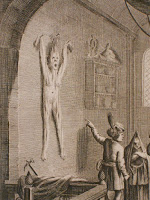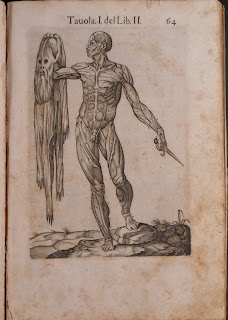 Jean Struys's sensational accounts of travels in the East established many of the western European myths about Persia. He took stories he heard on his travels and retold them as unquestioned truths to an audience eager for exotic tales of the East.
Jean Struys's sensational accounts of travels in the East established many of the western European myths about Persia. He took stories he heard on his travels and retold them as unquestioned truths to an audience eager for exotic tales of the East. One story he recounted was of a woman captured and forced into a Persian harem. She tried to escape, was captured, then flayed alive as punishment. Her husband displayed her skin as a warning to his other wives, or so the story went. It is a horrific tale of misogyny that was illustrated in many editions of Struys's Voyages. The image here, from the French language edition Les Voyages de Jean Struys (Amsterdam: Ches la Veuve de Jacob van Meurs, 1681), shows both the flaying and the display of the skin. It depicts a scene of cruelty and torture that is made even more disturbing by the way it exploits the positioning of the woman to become almost pornographic.
One story he recounted was of a woman captured and forced into a Persian harem. She tried to escape, was captured, then flayed alive as punishment. Her husband displayed her skin as a warning to his other wives, or so the story went. It is a horrific tale of misogyny that was illustrated in many editions of Struys's Voyages. The image here, from the French language edition Les Voyages de Jean Struys (Amsterdam: Ches la Veuve de Jacob van Meurs, 1681), shows both the flaying and the display of the skin. It depicts a scene of cruelty and torture that is made even more disturbing by the way it exploits the positioning of the woman to become almost pornographic.Compare it to another scene of flaying in Juan de Valverde's Anatomia (Roma: A. Salamanea et A. Lafrerj, 1560). Here it is a man whose skin has been stripped off his body. But rather than being a victim, he is portrayed as a heroic figure displaying his exposed musculature to the world as an example of the wonder of the human form. Moreover, he is given agency: it is his hand that holds the flaying knife. The contrast couldn't be more stark.
To see the Struys, ask for Rare G460.S934 1681. The Valverde is Rare QM21.V35.

No comments :
Post a Comment